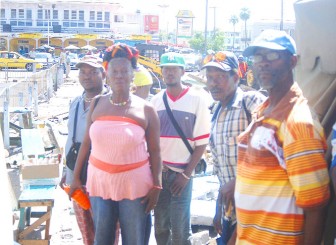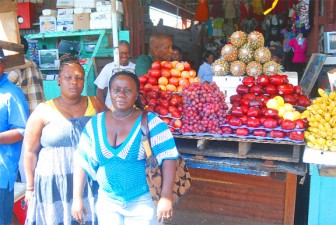Some of the street vendors displaced by the ongoing exercise being undertaken by government ostensibly to rid the Stabroek Market area of illegal physical structures and create an atmosphere that would discourage criminal elements, say they are willing to organise themselves into an association.
By so doing, they say, they hope to be able to engage government and the city on the matter of regularizing their activities, but they believe the lack of unity among the vending community as a whole is likely to stymie such efforts.

Colin Frith, whom, along with his wife Faye, who have been vending outside Stabroek Market for several years, told Stabroek Business on Wednesday that part of the problem faced by vendors is that over the years there had been no “coming together” to deal with issues that affect them. “The problem is unity,” Frith told Stabroek Business. He said that if such a body is to be set up the vendors would have to “sit and discuss the matter” and this, he said, “could prove to be a problem.”
Up to earlier this week discourse on the idea of setting up an umbrella body appeared to have made little progress. The City Council appeared preoccupied with the fallout from the government’s decision to take the initiative in removing illegal structures used by vendors for trading while the vendors appeared preoccupied with counting their losses and contemplating their future. This newspaper has in the past raised with both the Private Sector Commission and the Georgetown Chamber of Commerce and Industry whether registered vendors might conceivably become members of the Chamber. Neither organisation has commented one way or another on the idea though both have acknowledged the commercial legitimacy of the vending community.
Evidence of a lack of either strong representation or collective lobby for vendors emerged on Tuesday when several of them who claimed to have been displaced from the tarmac opposite the market made claims that goods valued at hundreds of thousands of dollars had been confiscated by the city police but appeared uncertain as to how and where to make effective representation to have their goods returned to them.

The Wednesday January 5 grenade explosion outside the city’s main municipal market has galvanized government into action to remove illegally erected makeshift stalls in the vicinity. Vendors whose stalls have been levelled were on Tuesday gathered close to the site of their demolished businesses, contemplating their loss of income and awaiting audience with Works Minister Robeson Benn whom they said had taken a list of the names of the displaced vendors and promised to relocate them.
Significantly, the aggrieved vendors appear to be looking to central government rather than to the municipality to resolve their woes.
When asked on Tuesday whether they had made any attempt to meet Mayor Hamilton Green most of the vendors said they felt that only government could make firm decisions in the matter.
The Friths are among more than 50 registered vendors who have since been given clearance by President Bharrat Jagdeo to resume their trading operations on condition that they operate between 06:00 hrs and 18:00 hrs. Frith feels nonetheless, that an umbrella body which also seeks to provide some measure of “cover” for vendors trading illegally was “a good idea”. Some of the displaced vendors including Jennifer Cummings, a mother of four and resident of the Soesdyke-Linden Highway whose snackette was demolished agreed that vendors needed someone “to talk for them.”
Stabroek Business has been unable to secure a comment from Clerk of Markets Schulder Griffith as to whether his office would be prepared to engage a body comprising the vendors. However, another City Hall official told this newspaper that the question of recognition of any such group would have to be dependent on the legitimacy of their operations of its members. The official said it was likely that some of the vendors who might conceivably become members of such a group are themselves trading illegally. “That would mean that the municipality would not want to deal with them,” the official said.
The issue of the legality of the vendors in the vicinity of the market is a matter of considerable complexity. Some who are believed to have been trading without official permission but who claim to pay “stand rent” to the City Police are angry over what, one vendor, Marilyn Abrigo, described as the suddenness of the clampdown. They are angry over the demolition of their stalls and the displacement of their businesses but say they are prepared to engage the authorities on the issue of regularizing their status.
Those vendors trading from collapsible stalls on the edge of the tarmac immediately east of the market say they are registered with the municipality. However, their status is not entirely without controversy.
According to Faye Frith, who evinced a decided reluctance to discuss the matter, the council has not been collecting rents from them “for the longest while,” though they are allowed to trade anyway. It is, it appears, a fluid situation in which the council appears unable to remove them but is decidedly reluctant to acknowledge their legitimacy.
On Tuesday, the ‘six to six’ vendors were waiting to engage the Works Minister over what they claim was a demand that the huge beach umbrellas placed in front of each stall to protect the occupants and the stock from the elements be removed. The vendors had complied but the fierce morning sun had given rise to both physical discomfort and concern over possible spoilage of perishables.
No one is clear as to the number of persons whose immediate future has been put at risk in the wake of the demolition of the stalls. One vendor estimated that at least a dozen structures of one kind or another had been removed.
A few who had lost their stalls or their places on the tarmac were wondering aloud as to how they would repay outstanding loans. Others, like Cummings, have other headaches. She travels to George-town every day to operate a food snackette outside the market. On Tuesday, she was awaiting the outcome of the Works Minister’s promised offer of relocation. Her children were not at school and she was angry.
Across the street, beneath the Stabroek market awning, another group of legitimate vendors appeared nervous. At least one stall, owned by Bernadine Harcourt and offering fruit for sale is partially blocking one of the main entrances to the market and the municipality, she says, wants it removed. The stall, Harcourt said, had been handed down by relatives over more than forty years. It can, it seems, be relocated in a manner such as not to encumber the entrance but that will require a ripple initiative in which two or three stands north of her own will be required to shift slightly.
The owners, Harcourt said, were not willing to make the shift and on Wednesday she was awaiting a ruling from the Clerk of Markets on the matter.





